This old-fashioned recipe for Scottish Barley Kale Broth is so simple and easy, yet packed with wholesome savoury fresh flavours. This tasty soup is perfect for light meals, or as a starter to stimulate the appetite, or even as a quick nourishing low-calorie and low-fat snack or winter-warmer. A bowl of Barley Kale Broth is especially ideal for those days when your feeling a little under-the-weather. And for gluten-free diets the barley can be easily replaced with rice for a gluten-free broth.

Inexpensive simple soups that are packed with plant-based nourishment are the epitome of traditional cozy home-cooking. Various versions of this humble Barley Kale Broth has been nourishing Scots for centuries.
What is Scottish barley kale broth?
Scottish Barley and Kale Broth is an old-fashioned traditional Scottish soup that has its roots in peasant and farmhouse cooking and has been around for centuries. It is prepared with just a few ingredients - barley, kale, and leeks, cooked within a broth which most likely would have been animal-based. Barley, kale, and leeks are traditional Scottish ingredients and would have been easily available.
Quick history of barley in Scotland
Barley has a long history in Scotland, where it has been cultivated for thousands of years. The ancient Picts, who inhabited Scotland before the arrival of the Romans, were known to have grown barley and used it to make beer.
In the Middle Ages, barley was an important crop for both food and drink, and was used to make bread, bannocks, porridge, and ale. By the 18th century, barley had become a very important crop in Scotland, and was used to make whisky, which has become an iconic Scottish drink.
Today, Scotland remains a major producer of barley, and it is home to many famous whisky distilleries that use the grain in their products.
Barley was and still is a delicious addition to tasty soups and stews, but surprisingly barley has also been used as a dessert. One example being this delicious old-fashioned Scottish Sweet Barley Pudding, which is similar to the more familiar family favourite Rice Pudding.
A few interesting Scottish barley facts
- Barley is one of the oldest cultivated grains in the world and has been grown in Scotland for thousands of years, it is considered an Ancient Grain.
- Barley was historically a staple food in Scotland, particularly in the Highlands, where it was more commonly grown compared to oats in some regions.
- Pottage, a traditional British medieval dish, was often made using barley along with other available vegetables.
- Barley Bannock is a traditional Scottish flatbread made from barley flour and it was commonly consumed as an everyday bread.
- Barley is a key ingredient in traditional Scottish soups like Scotch Broth, Cock-a-leekie, and Scottish Hotchpotch.
- Barley is crucial to the Scotch whisky industry as malted barley is one of the primary ingredients in many types of Scotch.
- Barley is also used in the production of traditional Scottish ales as its malt provides colour and flavor to the brew. Likewise barley is used to prepare the popular malt vinegar that is delicious sprinkled over potato chips or fries.
- The end of the old barley harvests, usually late summer, was often marked with celebrations, feasts and dancing.

Quick history of kale in Scotland
Kale has been grown in Scotland for centuries as this hardy vegetable is well-suited to the Scottish climate and soil conditions, and so was a staple crop for many farmers in rural areas. In fact, kale was so important to the Scottish diet that it was often referred to as "Scotch kale" in old cookbooks.
In the past, kale was typically boiled or stewed and served as a side dish with meat, fish, or prepared as a porridge. It was also used in a popular Scottish dish known as "kale brose," which was a simple oat porridge or soup made from kale and oatmeal.
During the 18th and 19th centuries, kale became even more important to the Scottish diet as a result of the Highland Clearances, which forced many rural residents off their land and into urban areas. Kale was a hardy and inexpensive vegetable that could be grown in small plots of land, making it a valuable source of nutrition for those who were struggling to make ends meet.

Kale is perfect for the soup pot!
My family live on a Scottish island, and so we often experiences 4 seasons in one day and one of my daughters best home-grown crops is usually kale, which seems to cope well with summer torrential rain and gale force winds!
I love that the kale flavour can often taste like seaweed, and when cooked briefly within soups, broths, or stews it can enrich the dish with deliciously fresh, nourishing seaside flavours. My family especially love a steaming hot bowl of this barley kale broth as a pick-me-up, to help get over whatever virus or bug is currently doing the rounds.
Besides, a humble bowl of barley kale broth is just traditional Scottish home-cooking at its best and maintains our connection to our ancestors. And best of all this tasty soup is budget-friendly and provides lots of valuable plant-based nutrition.
A few interesting Scottish kale facts
- The term "kail" or "kale" was once a generic term for dinner in Scotland, highlighting how common the vegetable was. The word has even made its way into expressions like "to come to kail" meaning "to come to dinner."
- Kale is often included as part of the traditional Burns Night supper, honoring Scottish poet Robert Burns.
- Kale is highly frost-resistant and can grow in winter, providing much-needed nutrients during the colder months.
- Kailkenny is a traditional Scottish dish made by blending kale with potatoes and occasionally adding other ingredients like onions and cheese.
- During Hogmanay (Scottish New Year), it was traditional to eat a meal of "kail and herrin'" (kale and herring) to bring good luck for the coming year.
- The Kailyard School was a literary movement in Scotland that took its name from the traditional "kailyard" or kitchen garden where kale was grown, emphasizing domestic Scottish life.
- Kale is rich in vitamins A, K, and C, along with other essential minerals and antioxidants, making it a great addition to your diet.
- In the past, kale was also believed to have medicinal properties and was used in folk remedies for ailments like digestive issues and vitamin deficiencies.
- Kale is a good option for crop rotation because it has different nutrient needs and pest profiles compared to other commonly grown crops.
- Given its low need for pesticides and its ability to grow in colder climates, kale is considered a sustainable crop.

Quick history of leeks in Scotland
Leeks have been cultivated for thousands of years and are native to the Eastern Mediterranean and the Middle East. They spread across Europe with the expansion of trade and civilization and likely arrived in Scotland during the Roman era or even earlier, and soon became a staple in the Scots diet.
In Scotland, leeks have been grown for centuries and were considered more than just a food source as they were also a symbol of prosperity and protection, with many holding superstitious beliefs that leeks could ward off evil spirits, so they were often tied to doorways and stables for this purpose.
Leeks have always been a a feature in Scottish cooking as their versatility meant that they could be used in a wide range of dishes, from stews and soups like Cock-a-Leekie soup, to pies, casseroles and stews.
A few interesting Scottish leek facts
- While more commonly associated with Wales, some Scots wear leeks on St. David's Day (March 1st) to honor St. David, the patron saint of Wales, in respect of the historical alliances between the Scots and the Welsh.
- Leeks often feature in the traditional "Burns Supper," a celebration of the Scottish poet Robert Burns. Cock-a-Leekie soup is a common dish served during these festivities.
- In Scottish folklore, leeks are considered good luck and were sometimes hung on doorways to ward off evil spirits.
- Leeks are a quintessential "kailyard" (kitchen garden) vegetable in Scotland. Their ability to withstand the Scottish weather makes them a practical choice for local gardens.
- The traditional Scottish dish Rumbledethumps often includes leeks along with potatoes and cabbage. It's a comfort food classic in many Scottish homes.
- Leeks are one of the few vegetables that can survive the harsh Scottish winters, making them a vital food source during colder months.
- Leeks are closely related to garlic, and onions, which are also common ingredients used in traditional Scottish cooking.
- Leeks are rich in vitamins and minerals like Vitamin A, C, and K, as well as folate and manganese. Their nutrient profile makes them a healthy addition to any meal.
- Leeks are a good crop for rotations, as they help break pest and disease cycles and improve soil health.
- In Scotland, leeks are traditionally planted in trenches rather than holes, which is said to grow larger and straighter leeks.
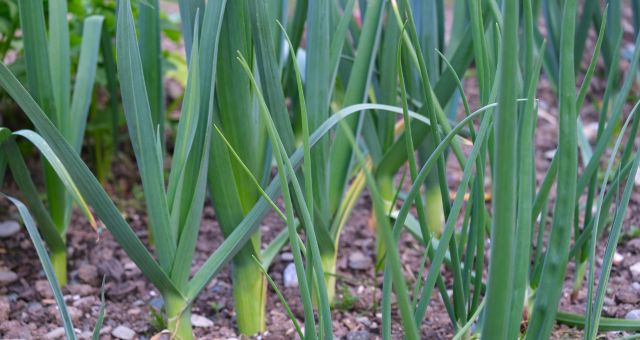
How to prepare Scottish barley kale broth
This tasty traditional Scottish soup is really easy to prepare. Its just a case of cooking the barley in a savoury stock for 30 minutes, before adding the fresh kale and leeks and cooking the vegetables for a quick extra ten minutes. Delicious wholesome vegan food doesn't have to be a faff to cook!

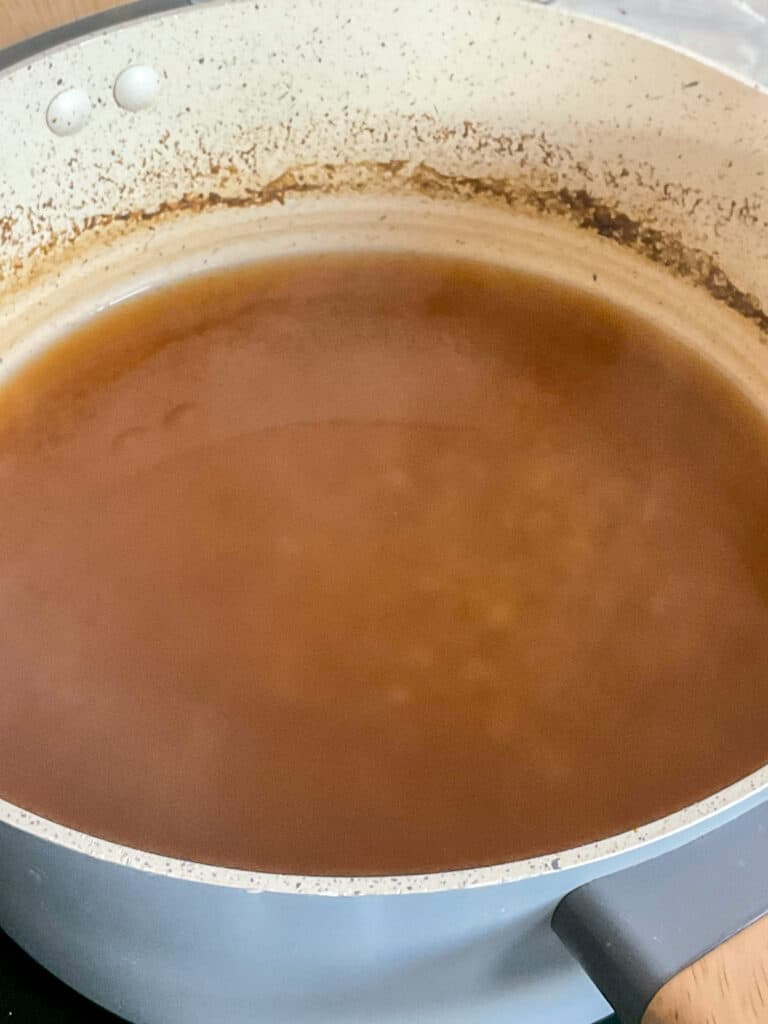
First add the pearl barley, bay leaf, marmite [vegemite or yeast extract] and hot vegetable stock to a soup pan.
Bring to the boil and simmer for 30 minutes.
[If your not keen on marmite it can be replaced with miso paste, as this will still contribute a nice savoury flavour.]

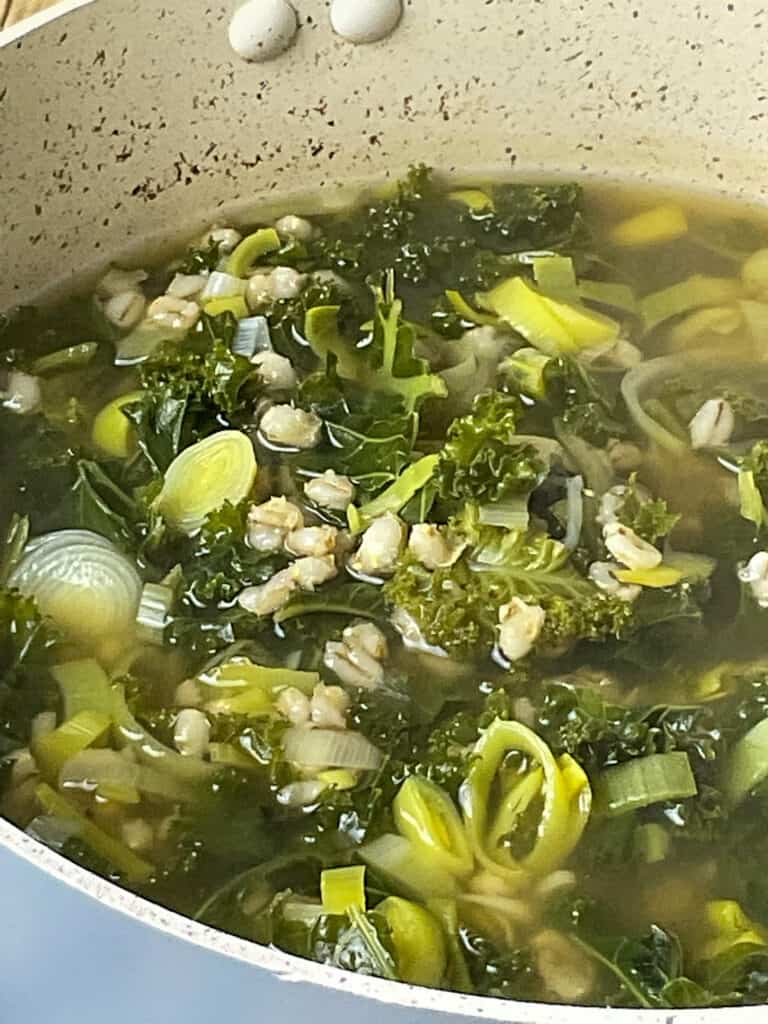
Add the leeks and kale and cook for 10 minutes.
Season with salt, plenty of black pepper, and fresh parsley to taste.

Barley kale soup is perfect paired up with your favourite bread or Scottish Oatcakes, such as our delicious easy Irish wheaten [soda] bread, or Australian Damper Bread or this Slow Cooker Cornbread. Or go for a tasty just-out-of-the-oven home-baked Vegan Buttermilk Scone or Vegan Cheese Scone. For oil-free Scottish oatcakes have a look at our Oil-Free Scottish Oatcakes and our Oil-Free Scottish Cheesy Oatcakes recipes.
Recipe notes
Storing
Store leftover broth within the refrigerator for 2-3days or freeze for 2-3 months.
Reheating
To reheat leftover, add the soup to a saucepan and bring to the boil, lower the heat and simmer for 2-3 minutes until piping hot. Before reheating, add a little extra veggie stock if necessary as the barley will likely continue to soak up the broth as its stored.
Pearl barley is used for this recipe as it cooks relatively quickly and has a pleasant texture and subtle flavour. Pearl barley is a grain that has had the inedible outer husk and edible bran removed, as opposed to hulled barley which retains some of the fibre rich bran.
Barley is a great addition to a balanced diet as it is an excellent source of dietary fiber, containing both soluble and insoluble fiber, which can help promote digestive health and reduce the risk of certain diseases.
Barley is also a good source of plant-based protein, providing all the essential amino acids needed by the human body. It is rich in vitamins and minerals, including vitamin B6, iron, magnesium, zinc, and selenium, which play important roles in supporting immune function, promoting healthy bones and muscles, and protecting against oxidative stress.
Additionally, barley contains phytonutrients such as lignans and phenolic acids, which have antioxidant and anti-inflammatory properties.
Unfortunately barley contains the protein gluten so is not suitable for those requiring a gluten-free diet.
Yes, if a gluten-free grain is required then barley can be easily replaced with rice. Any variety of rice is fine including brown, wholegrain, or black rice, however depending on the package instructions you may need to cook the rice for more or less time compared with pearl barley. Wild rice can also be used although technically this type of rice is actually a grass.
To enjoy this broth as gluten-free, the barley can be replaced with rice, and a gluten-free vegetable stock can be used. As marmite [yeast extract] is not gluten-free it will need to be replaced with an alternative such as a gluten-free miso paste, or a few tablespoons of gluten-free soy sauce such as Tamari or liquid coconut aminos. Although, there are gluten-free yeast extracts so if you find one for sale in your local store its worth picking up as a small jar can be used for many recipes.
Yes, the kale can be switched out for collard greens, spring greens, cabbage, chard, turnip greens, or any green leaf veggie you prefer.
Absolutely, adding additional vegetables or proteins like tofu or beans is a great way to make the Scottish Barley Kale Broth more filling and add extra nutrition. Here are a few suggestions:
1. Vegetables:
* Sliced or diced carrots would add colour, sweetness, and additional nutrients.
* Cubed potatoes can make the soup heartier.
* Sliced mushrooms would give the soup an earthy flavour.
* Adding some diced celery could provide a nice crunch and extra tasty flavours.
2. Protein:
* Cubed firm tofu or crumbled tempeh can be added for a protein boost.
* Cooked chickpeas, haricot beans [navy beans], or kidney beans can make the soup even more filling. If using canned beans, make sure to drain and rinse them before adding.
* Lentils can be added and green or brown whole lentils would be a good choice but do cook them until nearly soft before adding the kale and leeks.
3. How to Incorporate:
* For hard vegetables like carrots, celery, and potatoes, you can add them early in the cooking along with the barley so they have time to soften.
* For softer vegetables like mushrooms you may want to add them halfway through so they don't become too soft.
* Beans and other proteins can be added towards the end, especially as they are already cooked and only need warming through.

More oil-free vegan soups
For many of our vegan versions of traditional soups, oil, vegan butter, or margarine is not required as the flavours of the ingredients are enough to provide delicious bowls of soups. Here are a few more of our favourite no-oil vegan soup recipes:
***please note: for US measurements click the 'US customary button' within the recipe and the measurements will switch to tablespoons, cups, and ounces.***
📖 Recipe

Scottish Barley Kale Broth
Equipment
- large soup pot
Ingredients
- 100 grams pearl barley [washed and drained] [replace with rice for a gluten-free option if preferred]
- 160 grams kale [remove large stalks and tear large pieces up using your hands or slice with a knife]
- 200 grams leek [sliced into thin rings/larger pieces sliced into thin half moons/crescent shapes]
- 1 bay leaf
- 1 teaspoon marmite [yeast extract] [can replace with miso paste if preferred, or Tamari soy sauce is gluten-free required]
- 3 litres vegetable stock [hot] [use a vegan 'beef' flavour stock if available, and use a gluten-free stock if necessary]
Garnish, optional
- 2 tablespoon fresh parsley [or to taste, can replace with a herb of your choice]
- a sprinkle of nutritional yeast flakes or some toasted seeds are also a tasty addition
Instructions
- Add the pearl barley, bay leaf, marmite and hot vegetable stock to a soup pan. Bring to the boil, lower the heat to medium, and cook for 30 minutes,100 grams pearl barley, 1 bay leaf, 1 teaspoon marmite, 3 litres vegetable stock
- Next add the chopped kale and sliced leeks.160 grams kale, 200 grams leek
- Bring back to the boil, and cook for another 10 minutes.
- Remove the bay leaf.
- Season with salt and plenty of black pepper to taste. Sprinkle some fresh parsley over each bowl if liked. [A sprinkle of nutritional yeast flakes is a nice optional addition, as are a sprinkle of toasted seeds.]2 tablespoon fresh parsley
Notes
- Nutritional data is provided for guidance only and is not an exact calculation of your dish as ingredients can vary.
- Store leftover soup for 3 days within a refrigerator, or freeze for 2-3 months.
- Reheat leftover soup until piping hot.
- For gluten-free kale barley broth use a gluten-free stock and replace the barley with a rice of your choice. As marmite [yeast extract] is not gluten-free it can be replaced with a certified gluten-free yeast extract or 2 tablespoons of Tamari soy sauce or liquid coconut aminos.
- Miso paste can also be used to replace the marmite or yeast extract if liked better.
- Kale can be switched out for collard greens, chard, spring greens, turnip greens, cabbage, or your preferred green leaf vegetable.
Nutrition
Prepared this tasty Scottish barley kale broth? We would love to know how you got on with the recipe. Do drop us a comment below and click the star ratings. All feedback is very much appreciated. Thanks so much! Jacq x




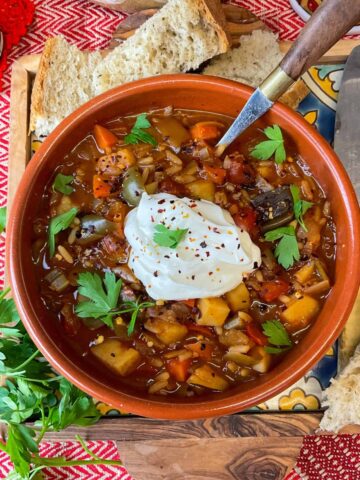
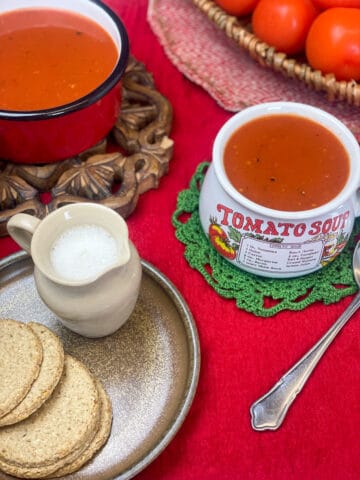




Leave a Reply